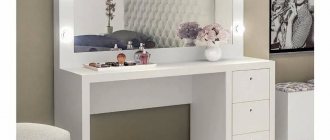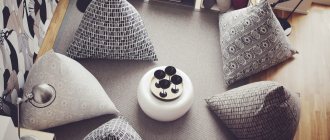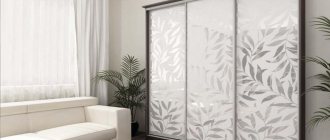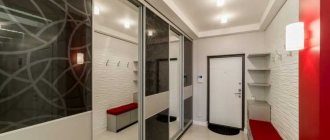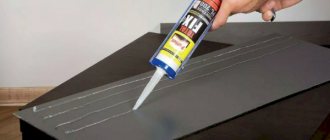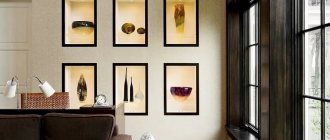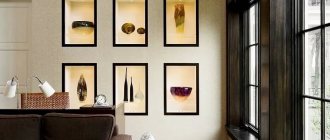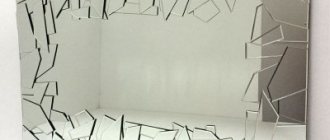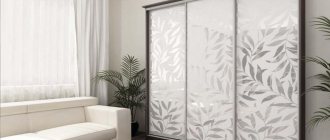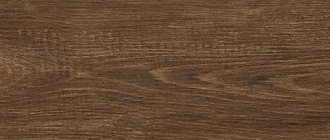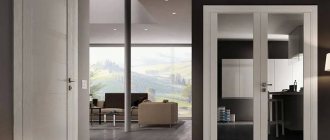Mirrors are among the familiar objects that have surrounded humans since time immemorial. To date, they have learned to decorate them in different ways; Popular design techniques include beveling. Its popularity is explained by the fact that such a beveled mirror has a stylish look and helps to decorate any interior in a more interesting way.
In a classic interior Source images.homify.com
About technology
Bevelling as a method of processing glass or mirror canvas arose several centuries ago. It involves grinding the edge of the material at a certain angle, resulting in a chamfer. The word “facet” itself is of French origin and means “chamfer, outer edge.”
By the end of the 20th century, high-precision equipment appeared that made it possible to produce bevels automatically. Now the surface is ground down, smoothed and polished according to the specified profile. The resulting edge angle refracts light in a complex way and creates an interesting lighting effect, for which the bevel on the mirror is valued; What’s nice is that the frame is absolutely safe. Because the edge is ground and polished, it is impossible to cut yourself on it.
The angle and size of the bevel are not set arbitrarily; their magnitude depends on the thickness of the mirror. For a canvas with a thickness of 4-20 mm, the width of the bevel (in the case of straight processing) is 4-30 mm. The dimensions are selected carefully, otherwise the mirror is likely to crack or begin to crumble.
Design in a modern style Source design-homes.ru
Features of beveled mirrors
Bevel is the processing of the front side of the mirror at an angle of up to 45 degrees. The width of such processing reaches 50 mm. The application method is suitable for rectangular and curved shapes. Thanks to this technique, any mirror surface takes on a sophisticated look.
In the interior, such options emphasize the unusualness of the decor and give it a complete look.
The bevel is also important from a practical point of view: the processed edges are safe for those who come into contact with them.
Types of facet
The end of the mirror surface is cut in two ways:
- One-sided (simple) bevel. The face is obtained after performing a single cut; Such mirrors are widespread due to their low cost.
- Bilateral. The chamfer is removed from the front and back parts of the product, increasing the shine of the edges.
The following options are distinguished by form:
- Double, triple bevel. The chamfer is removed several times, with each subsequent bevel narrower than the previous one. Due to this complication, light hitting the surface is refracted more times. Refracted rays increase the shine of the facets to a “diamond”, enhancing the beauty of the play of light and color.
- Straightforward. It is made on canvas in the shape of a square, rectangle or any other shape that does not have smooth lines.
- Curvilinear. Beveled edges turn out to be curved if a round or oval product is processed, as well as a product with a decorative shape (for example, in the shape of a flower).
Decor around the headboard Source ksvmebel.ru
See also: Catalog of projects of two-story houses made of vulture panels
Types by processing method
According to the processing method, there are straight bevels, curvilinear bevels, as well as double and triple bevels.
Straightforward
The thickness of the mirror surface is 3-19 mm, and its minimum size is 50x50 mm
A straight beveled bevel is used to process mirror surfaces of simple shape, without rounded corners (for example, a square or rectangle).
The width of this bevel is from 4 to 30 mm. The cut is made at an angle of 3-7 degrees.
A straight chamfer is made for mirrors of regular shape
Curvilinear
The thickness of the canvas should be 3-19 mm, but its minimum size is 110 x 180 mm
Using curved bevelling, you can process mirrors shaped like a circle, oval, etc.
The width of the curved chamfer can vary from 5 to 50 mm. A chamfer is applied at an angle of 7-45 degrees.
Curvilinear is used along the contour of oval and round mirrors
Double and triple
With double and triple bevel, the cut is made two and three times, respectively. Moreover, each subsequent cut is narrower than the previous one.
Depending on the type of finish, beveled options can be matted or polished. Matted ones have a matte surface, while polished ones have a transparent surface.
Example of triple beveling
Advantages and disadvantages of facet coating
It may seem that the processing of the edge serves only the decorative function of the bevel on the mirror; but not everyone realizes that this way increases the safety of the product. When bevelling, special grinding machines are used. They process the sharp edge as precisely and carefully as possible, so that after finishing sanding you will not be able to cut yourself on the edge. The procedure does not affect the appearance or characteristics of the canvas in any way.
Bevelling eliminates small irregularities and chips that are somehow present on the workpieces and can cause cracks. Thus, the process increases the strength of the canvas.
The main reason for cutting is to solve decorative problems. A mirror or glass with a beveled coating invariably attracts the eye with the play of light on its edges and turns into a stylish element of the interior. The only disadvantage of such decoration can be considered the need for careful care using special products.
In the kitchen interior Source st.hzcdn.com
See also: Catalog of companies that specialize in the reconstruction and rebuilding of houses
What is
The term bevel originated in France and is translated as outer edge, chamfer. It was there that the technology of decorative processing of the edges of mirrors and glass was first used. Framing gives the surface a finished look; it is made at an angle of up to 45º, due to which light is refracted and a special shine is emitted, giving the product nobility and sophistication.
Today, the decoration of mirror cloth is carried out using special equipment. This allows you to create different types of bevels. The most widespread is the one-sided version, which consists of side edges beveled on only one side. More interesting is the double-sided one; another edge is made along the wide edge - a narrower one. This technique gives the frame brightness and expressiveness, and a unique radiance appears due to the double refraction of light.
The secret to the popularity of the facet is its incredible visual effects. The beveled edges refract the rays of the sun, like a prism, dividing the light into multi-colored components. Many people, having learned what a bevel is, dream of decorating their own home or office with a similar element.
It is almost impossible to cut yourself when touching the original frame. During the production process, sharp edges are smoothed and thoroughly polished, so the risk of injury is reduced to zero.
Facet
One-sided bevel
Double sided
Double
Faceted mirror in the interior
Beveled mirrors in the interior are a traditional way to decorate living rooms, bedrooms and bathrooms. Models with and without frames are equally popular. Frameless mirrors fit well into modern styles. A product with a baguette made of precious wood will perfectly complement a classic interior. The frame is matched to the interior style and gives the mirror a complete look.
In a baguette frame Source uf.ru
A faceted mirror cloth in an aluminum frame will fit into a high-tech or Scandinavian interior. In addition to wood and metal, plastic is used for framing frames. Thanks to special processing, the plastic frame is almost impossible to distinguish from stucco, and a mirror in a similar frame will decorate a living room or bedroom in the Art Nouveau style. Facet decor is also used in the following ways:
- Panel. Beveled mirror wall panels are common in European interior projects; they are among the common ways to decorate a living room. Typically, a panel is formed from diamond-shaped elements, which best refracts light rays and reflects them most effectively. If you want to use a small panel, draw maximum attention to it by hanging it, for example, above the fireplace.
Symmetrical panels in the bedroom Source design-homes.ru
- Mirror wall. A technique more often used in classic and modern interiors. Faceted decor occupies the entire wall and makes it the accent of the room. It is important to choose a wall next to the window, and place stylish light furniture in front of it; in this case, the reflection of light will be maximum, and the impression of the idea will be complete. You can put an interesting plant in front of the panel, and hang a picture on the opposite wall. Both will not go unnoticed.
Accent wall in the bedroom Source avatars.mds.yandex.net
- Bevel on furniture. An original way to decorate a room would be to choose furniture with a beveled mirror. Most often, a mirror surface decorates the doors of a cabinet or chest of drawers, but a coffee table with a voluminous tabletop can also become an interior highlight.
Sliding wardrobe Source www.ranak.me
- Mirror tiles. Small beveled mirrors are often used in interior decor. They replace regular tiles in the bathroom and kitchen, and are used as inserts in other rooms. Such tiles are wear-resistant and not afraid of moisture, and have a wide variety of shapes, from rhombic to round.
In the dining room Source i.pinimg.com
How to choose the right one
Here is a list of basic rules that should be followed when choosing a beveled mirror surface:
- Pay attention to the material that was used in production. Ask the seller for a manufacturer's certificate. If the mirror is made of sheet silicate glass of the M1 - improved, M2 - mirror, M3 - polished window grades, then feel free to purchase the product.
- Look at the thickness of the product: the ideal thickness is 4-6 mm.
- Assess the surface: it should be free of scratches, dents, bubbles and other defects.
- Pay attention to the protective coatings on the back of the mirror. The silver film, which creates a reflective effect, is not enough to talk about a quality product. Good manufacturers cover the reverse side with a copper anti-corrosion film and a layer of paint. The highest quality options are also treated with a polymer layer, which prevents them from crumbling into fragments when broken.
- Carefully inspect the edge: high-quality edges will extend the life of the product and ensure your safety when in contact with the mirror.
Mirror design
There are many interesting examples of beveled mirror design; Few people know that this is such a multi-faceted decor. Products in a baguette frame emphasize the elegance of the interior, and the mirror panel not only doubles the amount of light, but also creates a feeling of airiness even in a solid-looking living room. In addition to these options, there are other ways to use shining decor:
- Mirror with a wide bevel around the perimeter. We implement this option for spacious rooms and large format products. When these rules are followed, a wide bevel looks amazing and the room looks more presentable.
With a wide bevel around the perimeter Source vatikam.s3.amazonaws.com
- Double facet. It can be used not only as an edge processing method, but also as a mirror frame. This diamond cut in itself is a spectacular decorative element for any setting.
Italian design Source www.mebel-mr.ru
- With backlight. Illuminated beveled mirrors are often installed in the bathroom. They have a high level of moisture resistance, are equipped with a lens, LED strip (LED) and an aluminum body.
With LED lighting Source design-homes.ru
- Matte. The characteristic rough surface texture, the result of special processing, allows you to realize different design ideas. Both matte wall panels and furniture with matte fronts will have a stylish look.
With matte surface Source design-homes.ru
What types of facets are there?
Based on the type of execution, bevels on glass and mirror panels are classified into two types:
- Single. A classic bevel, which is a single wide line along the edge of the canvas.
- Double. In this case, another, but narrower, bevel is applied on top of a single wide bevel.
Facets can also be classified into straight and curved. The latter are made only on mirror or glass products of a curved shape and are characterized by high decorativeness.
